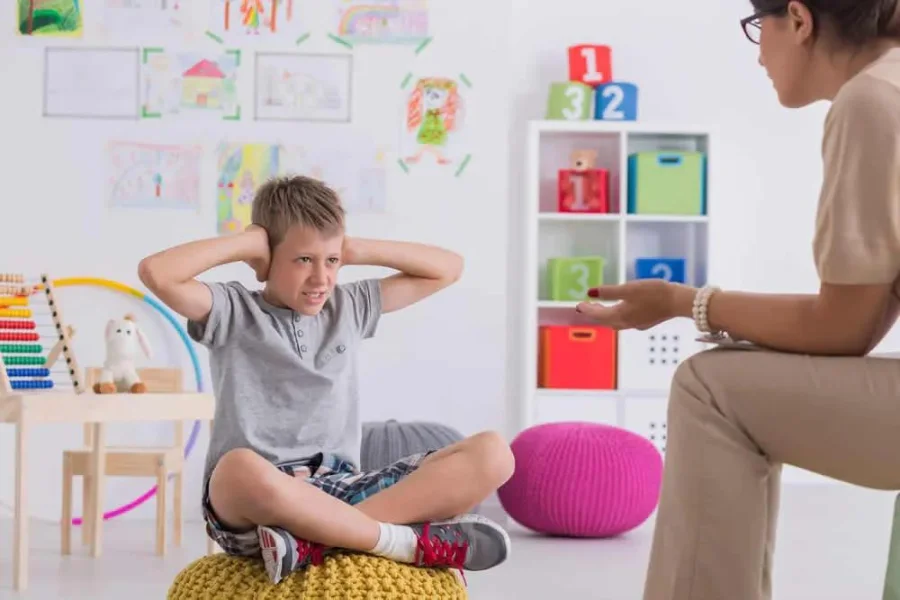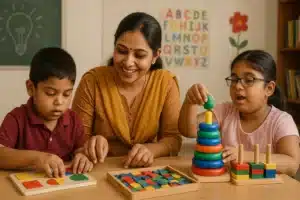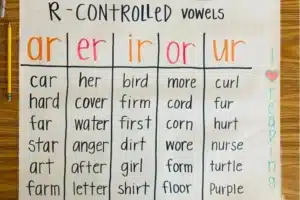
Source: medium
Holding an educational credential in the field of Special Education is a must in today’s educational scenario. Schools always prefer candidates who have a fair idea of addressing the academic, emotional, and behavioural needs of children who might possess any learning or physical disabilities. Before entering the realm of Special Education candidates should do their research as to which is the right Institute for Online Special Education certification programs with genuine govt registration that ensures great credibility for your resume.
Pursuing an Online Special Education Certification Program has made learning accessible to a wide section of candidates who due to any reason cannot opt for a full-time program. Online Learning has made it extremely easy for candidates to acquire a genuine educational qualification from the comfort of their home at a pace which suits them the most.
Vidhyanidhi Education Society one of the Leading Names in the field of Teacher Training has launched top-notch Online Special Education Programs qualifying candidates to kickstart a flourishing Special Education Career at some of the most prestigious schools.

Source: reekooz
What is Diploma in Learning Disabilities Course?
A Diploma in Learning Disabilities Course is a specialized training program designed to help educators, caregivers, and professionals address the unique needs of kids who face difficulties in learning. This program provides a deep understanding of various learning disabilities, preparing applicants with practical strategies to support these children efficiently. It mergers theoretical knowledge with practical practices, ensuring a well-rounded method to inclusive education.
Key Aspects of the Diploma in Learning Disabilities Course:
Understanding Learning Disabilities
Participants learn about various learning disabilities such as:
Dyslexia
Difficulty in reading and interpreting words.
Example: A child might mix up letters like “b” and “d” or struggle to read fluently.
Dyscalculia
Challenges in understanding numbers and mathematical concepts.
Example: A student may find it hard to grasp basic arithmetic, such as addition or subtraction.
Dysgraphia
Issues with writing, spelling, and fine motor skills.
Example: A child might have messy handwriting or face difficulty in spelling common words.
Assessment Techniques
- The course teaches how to identify and assess learning disabilities using tools like:
- Informal assessments like observation and interview.
- Observational techniques for spotting early signs of learning difficulties.
Example: Teachers may use these tools to assess why a child struggles to retain information from reading activities.
Intervention Strategies
- Participants master remedial teaching techniques tailored to different learning challenges:
- Multi-sensory teaching methods: Combining visual, auditory, and physical approaches.
Example: Using sandpaper letters for a kid with dyslexia to feel the shape of letters while saying their sounds aloud.
Individualized lesson plans
Designing specific activities based on a kid’s unique strengths and weaknesses.
Classroom Management
- The course covers strategies to create an inclusive environment, such as:
- Seating arrangements that reduce distractions for children with attention issues.
- Visual aids like charts and color-coded instructions for better comprehension.
Example: For a child with dyscalculia, using a visual number line to simplify understanding of addition and subtraction.
Parental Guidance
- Participants learn how to collaborate with parents to support children at home:
- Sharing strategies like using flashcards for reading practice.
- Encouraging open communication about the child’s progress.
Example: A parent might be taught to incorporate daily word games to enhance their child’s vocabulary.
Benefits of the Diploma in Learning Disabilities Course
- Enhances skills to address the diverse needs of students.
- Prepares candidates for roles like special educators or counselors.
- Helps to build a supportive framework for children to success educationally and socially.
By pursuing a Diploma in Learning Disabilities Course, individuals can make a significant difference in the lives of children who face learning challenges. The course not only strengthens professional expertise but also promotes an inclusive approach to education that benefits both children and society.

Source: istockphoto
What are Remedial Teaching Strategies?
Every Child aims to learn at the same pace in a regular classroom but however this is not always the case. Some children might not learn in the same manner as everyone else due to which there are chances of them lagging. Remedial Teaching here plays a very important role by providing students the assistance and guidance so that they can cope up well without acquiring a failure mindset.
Remedial Teaching Strategies are exclusively designed approaches that are meticulously designed keeping in mind the strengths and weaknesses of the child enabling the to grasp concepts better and learn confidently.
Some of the most effective strategies have been listed below:
Effective Remedial Teaching Strategies
Individualized Instruction
Tailor lessons based on the student’s strengths, weaknesses, and learning pace.
Use diverse teaching methods like visual aids, hands-on activities, or simplified explanations to meet unique learning styles.
Example: For a student struggling with reading, provide phonics-based instruction and allow practice at their own pace.
Multi-Sensory Learning
Engage multiple senses—visual, auditory, and kinesthetic—to make learning more impactful.
Example: Use tactile tools like sandpaper letters for alphabet learning, or incorporate movement-based activities for kinesthetic learners.
Breaking Down Concepts (Chunking)
Divide complex topics into smaller, manageable steps to simplify understanding.
Example: When teaching fractions, start with basic concepts like halves and quarters before moving to mixed numbers.
Scaffolding
Provide temporary support to help students grasp new concepts, gradually reducing assistance as they grow confident.
Example: When solving math problems, first solve similar examples together, then allow the student to attempt with guided prompts, eventually progressing to independent work.
Regular Feedback and Assessment
Use formative assessments to monitor progress and pinpoint areas for enhancement.
Provide constructive feedback that highlights strengths while addressing challenges.
Example: After a writing exercise, offer specific suggestions on sentence structure while praising vocabulary choices.
Interactive Tools and Technology
Leverage educational apps, games, and digital simulations to make learning engaging and accessible.
Example: Use apps that teach math through puzzles and games for practice in a fun, interactive way.
Positive Reinforcement and Encouragement
Celebrate achievements, focusing on effort and improvement.
Example: Reward milestones like completing a challenging reading passage with verbal praise or a certificate of achievement.
Collaboration and Peer Support
Encourage teamwork through peer tutoring and group activities.
Example: Pair a struggling student with a peer tutor to work on math problems together.
Building Confidence and Motivation
Focus on the student’s strengths to foster a positive self-image.
Example: A student excelling in art but struggling in writing can create visual representations of stories to build motivation.
Communication and Collaboration
Work with parents, educators, and specialists to make a unified method to support the student.
Example: Regular parent-teacher meetings to discuss progress and adapt teaching strategies as needed.
Applying Remedial Teaching Strategies ensures that students struggling with specific areas receive the support they need to succeed. With the right tools, encouragement, and a personalized approach, teachers can help these students overcome difficulties and build a strong foundation for lifelong learning. These strategies transform challenges into opportunities, helping every student feel confident, capable, and ready to achieve their best.
Ready to make a difference? Join Vidhyanidhi Education Society’s SEN Course and boost your career!
For more details on the SEN Course Call/Whatsapp at +919321024137 / +919869866277
To download the brochure of the SEN Course, Click Here!
Special Education Certification
FAQs
What is the Qualification of a Special Educator?
To be a Remedial tutor, you usually need an HSC qualification to pursue a special education course or related field experience, along with certification and dedication for better learning.
Which Course is best for Special Education?
Vidhyanidhi Education Society offers top-tier Special Education courses, providing flexible online learning options and practical knowledge to excel in the field of special education.
What is the Scope of Special Education?
Special Education offers various opportunities in schools, remedial tutoring, and consulting, with increasing demand for skilled professionals across the globe.



